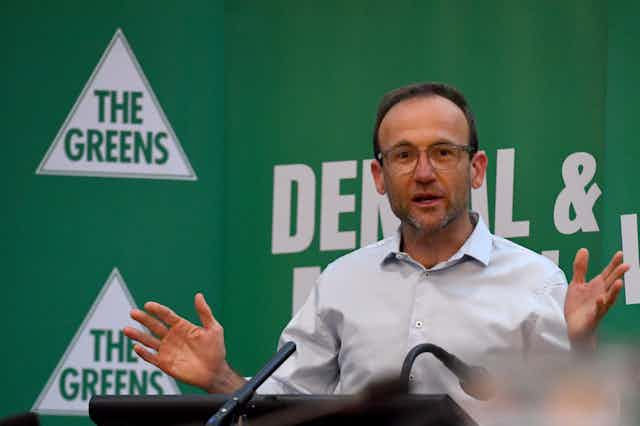The Greens have long battled against the perception they’re the radical fringe or the electoral ingenues of Australian politics.
Today, neither of these labels bedevil them in quite the same way they might have previously.
Two factors make it increasingly difficult to typecast the Greens in these terms. First, the issue that elevated the Greens to electoral prominence – the environment – is no longer an abstraction for the public.
The second is the party is a known quantity. The Greens’ federal leader, Adam Bandt, is ensconced in one of the safest federal seats in the country, and is also one of Australia’s most “believable” politicians, according to the Believability Index 2022.
So what are the Greens’ prospects this federal election?
Although the electoral and political context is more amenable to the Greens’ message than ever before, it may not translate into a dramatically improved vote.
More experienced
The Greens’ experience is showing in their approach to the campaign.
The messaging around the party’s policy agenda is more disciplined and strategic.
Consider, for example, its net zero carbon economy agenda. The party’s commitment to a net zero carbon economy is unchanged, but it’s more adept at foregrounding the importance of a transition “plan” and guaranteeing affected communities won’t be left behind. Bandt even paid homage to coal workers:
We owe coal workers a debt of thanks for powering our country. We don’t need to choose between taking urgent climate action and supporting coal communities. We can do both.
Crowded electoral space
Campaigns are always noisy affairs, and 2022 is no exception.
In addition to the usual problem of visibility in an electoral context dominated by the two major parties, compounding the situation for the Greens is Clive Palmer’s extraordinary media advertising purchase power, and the fascination with the “teal” independents.
The problem of visibility in a crowded electoral space is reflected in the opinion polls.
If current trends are any indication, the Green vote won’t surge (with the possible exception of stronger growth in Queensland) but will remain stable at 10-11%.
Seats to watch
Nevertheless, every election presents opportunities, and the Greens rate their prospects in eight lower house seats:
Brisbane (LNP), Griffith (Labor) and Ryan (LNP) in Queensland
Higgins (Liberal), Kooyong (Liberal) and Macnamara (Labor) in Victoria
Richmond (Labor) in NSW
and Canberra (Labor) in the ACT.
With the exception of Richmond, these are inner metropolitan seats. They’re also seats where the Greens have attracted over 20% of the primary vote, and the party has shown consistent vote gains over the past three electoral cycles.
However, some of these seats are more promising propositions than others. The Greens’ prospects are strongest in Liberal-held seats where their candidate has previously finished in second position, or in Labor-held seats where there is little difference in the Greens and Labors’ primary vote. Another useful requirement is that the incumbent’s primary vote is under 40%.
Based on this, Brisbane, Ryan, Kooyong and Higgins are likely dim prospects. In these seats, the incumbent’s primary vote was over 45% in 2019 and, with the exception of Kooyong, the ALP candidate polled in second place. The swing against the incumbent is likely to benefit Labor, assuming the electoral momentum in Labor’s favour holds.
The outlier of the four Liberal seats is perhaps Kooyong, because of Monique Ryan, one of the “teal” independents.
Kooyong becomes very competitive for the Greens if Ryan is able to attract double digit support away from Liberal incumbent Josh Frydenberg, but fails to surpass the Greens’ vote. If so, it might be an exciting finish for the Greens, even if Frydenberg is still widely tipped to win.
The situation is more dynamic in Canberra, Macnamara and Griffith. Here, Labor’s primary vote is under 40% (or slightly over 40% in the seat of Canberra) and the Liberals typically finish in second position behind Labor.
These seats become winnable for the Greens if the Liberal vote collapses and the Greens emerge as the main beneficiary of this collapse. Under these conditions, these seats should become a two-way contest between Labor and the Greens.
Preferences?
Whether the Greens succeed in winning these seats will, of course, depend on how the preferences of excluded Coalition candidates split.
We don’t have much federal data on this but based on the distribution of Liberal preferences in the seat of Melbourne in 2013, the overwhelming majority of these votes transferred to Labor.
Yet more recent state electoral data indicates the Greens can also emerge as the main beneficiaries of the votes of excluded Liberal candidates.
Of course, there are still a lot of unknowns, such as the actual size of Labor’s much vaunted swing and in which states and seats, as well as the lower house preference strategies of the major parties.
In spite of the Greens’ optimism, its sluggish ad spend in most of their targeted lower seats suggests they’re quite cautious about their prospects.
Whatever the outcome in the House of Representatives, the Senate presents an opportunity to build the party’s representation in the powerful upper house. Of the Greens’ nine serving senators, three are up for reelection.
If the party is able to maintain its primary vote, it will swell its ranks to 12 senators, returning it the balance of power in the Senate.

